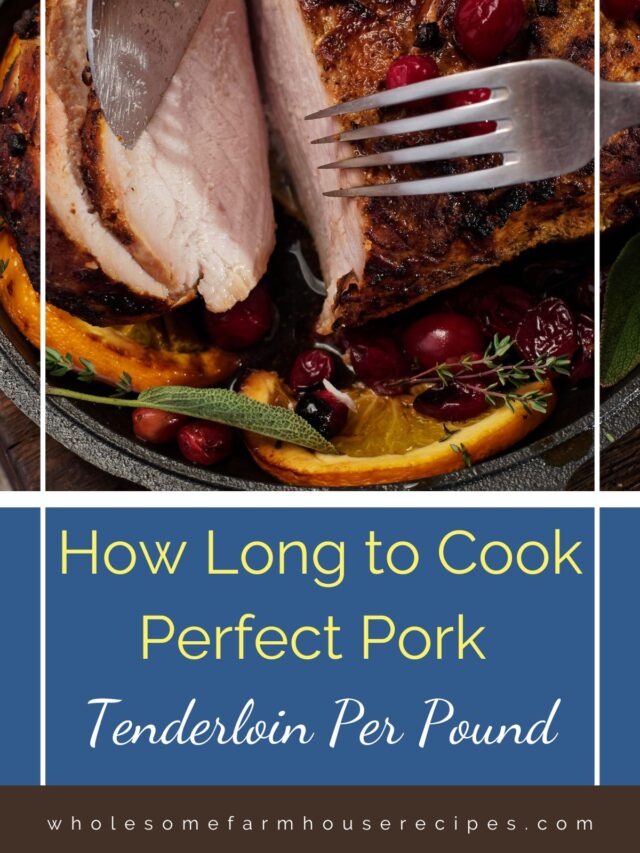Cooking a perfect pork tenderloin is a culinary feat that can impress even the most discerning palates. With its lean and tender meat, pork tenderloin is a versatile and delicious choice for any meal.
However, achieving that ideal combination of tender, juicy, and flavorful pork can be a challenge, especially if you’re not sure how long to cook it per pound.
The good news is that with the right techniques and a little know-how, you can easily master the art of cooking pork tenderloin to perfection.
In this article, we’ll explore the factors that influence cooking time, provide a detailed guide on how long to cook pork tenderloin per pound, and share a mouthwatering recipe and tips to ensure your pork loin is always a succulent masterpiece.
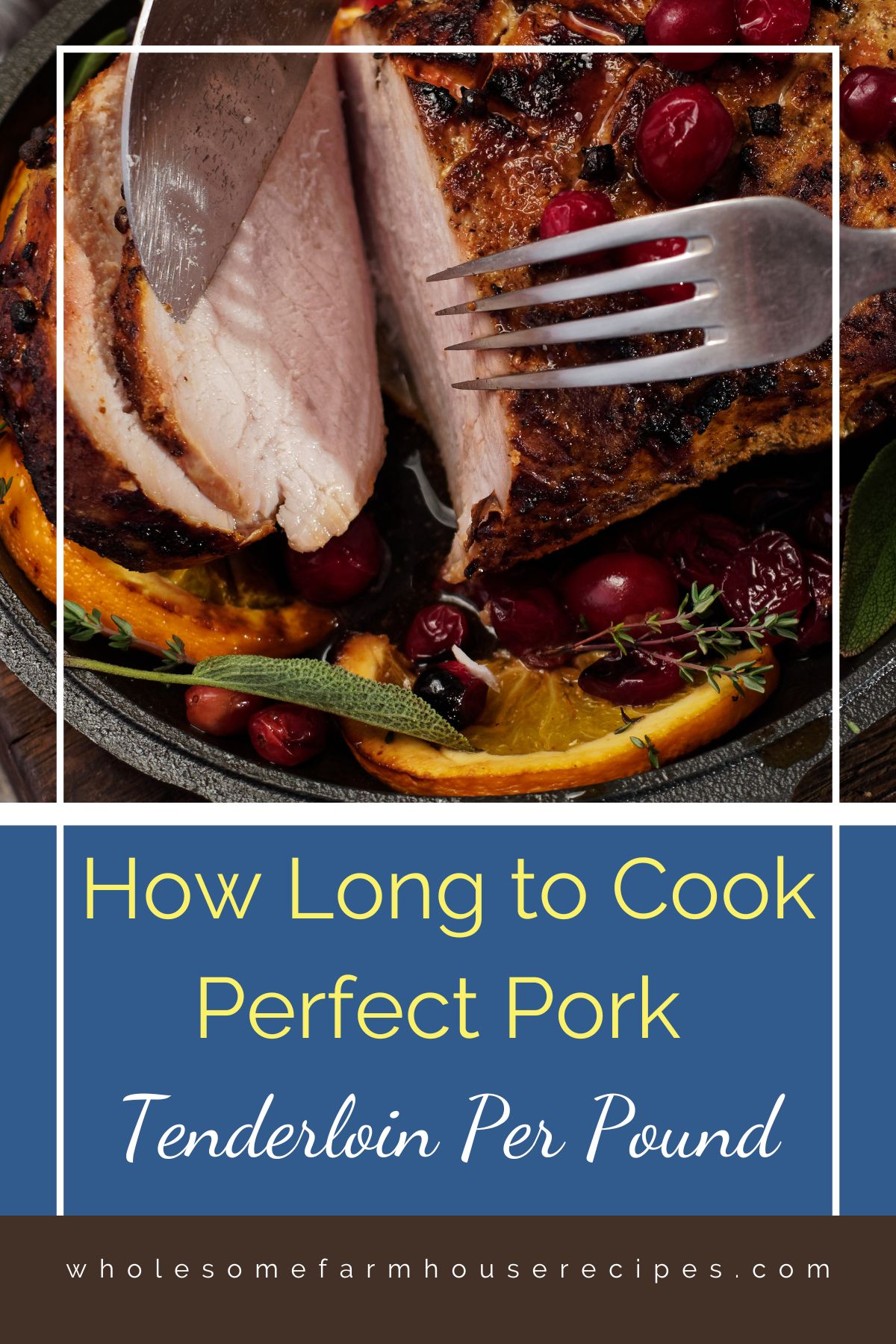
Why is Pork Tenderloin a Popular Choice for Cooking?
Pork tenderloin, often dubbed the “other white meat,” which was an ad campaign that launched in 1987 by The National Pork Board.
Since then, it has gained in popularity in the culinary world for several compelling reasons. Whether you’re a seasoned home cook or a professional chef, the allure of pork tenderloin lies in its unique combination of characteristics that make it a sought-after choice for countless recipes and occasions.
One such recipe is Stuffed Pork Tenderloin. It is dinner guest worthy yet it comes together rather quickly, thanks to the shortcut of instant stuffing mix.
Lean and Tender Meat
It is exceptionally lean, making it a prime selection. Its lack of excess fat marbling sets it apart from other pork cuts, making it an excellent choice for individuals who are aiming to maintain a balanced diet. The absence of excess fat also allows the meat to absorb flavors from seasonings and marinades, enhancing its overall taste.
Whether you prefer to roast, grill, pan-sear, or even slow-cook, it adapts to various cooking techniques, making it suitable for different cooking preferences and skill levels. This flexibility enables you to explore a wide range of recipes and flavor profiles, from classic preparations to innovative, contemporary dishes.
Quick Cooking Time
It has a relatively quick cooking time compared to other cuts of pork. With the right cooking method and temperature, it can be ready to serve in as little as 20-30 minutes. Making this perfect for busy weeknights or when you need to prepare a meal in a hurry. Its speedy cooking time makes it a reliable choice for those seeking a delicious and satisfying dinner without the long wait.
The tenderloin cut has a mild and slightly sweet flavor profile, which is perfect for a wide range of seasonings, herbs, spices, and sauces. This adaptability makes it a go-to choice for cooks interested in creative culinary exploration.
Whether you’re planning a simple weeknight dinner or an extravagant feast, pork tenderloin’s qualities ensure that it remains a beloved and dependable choice for a wide array of culinary creations.
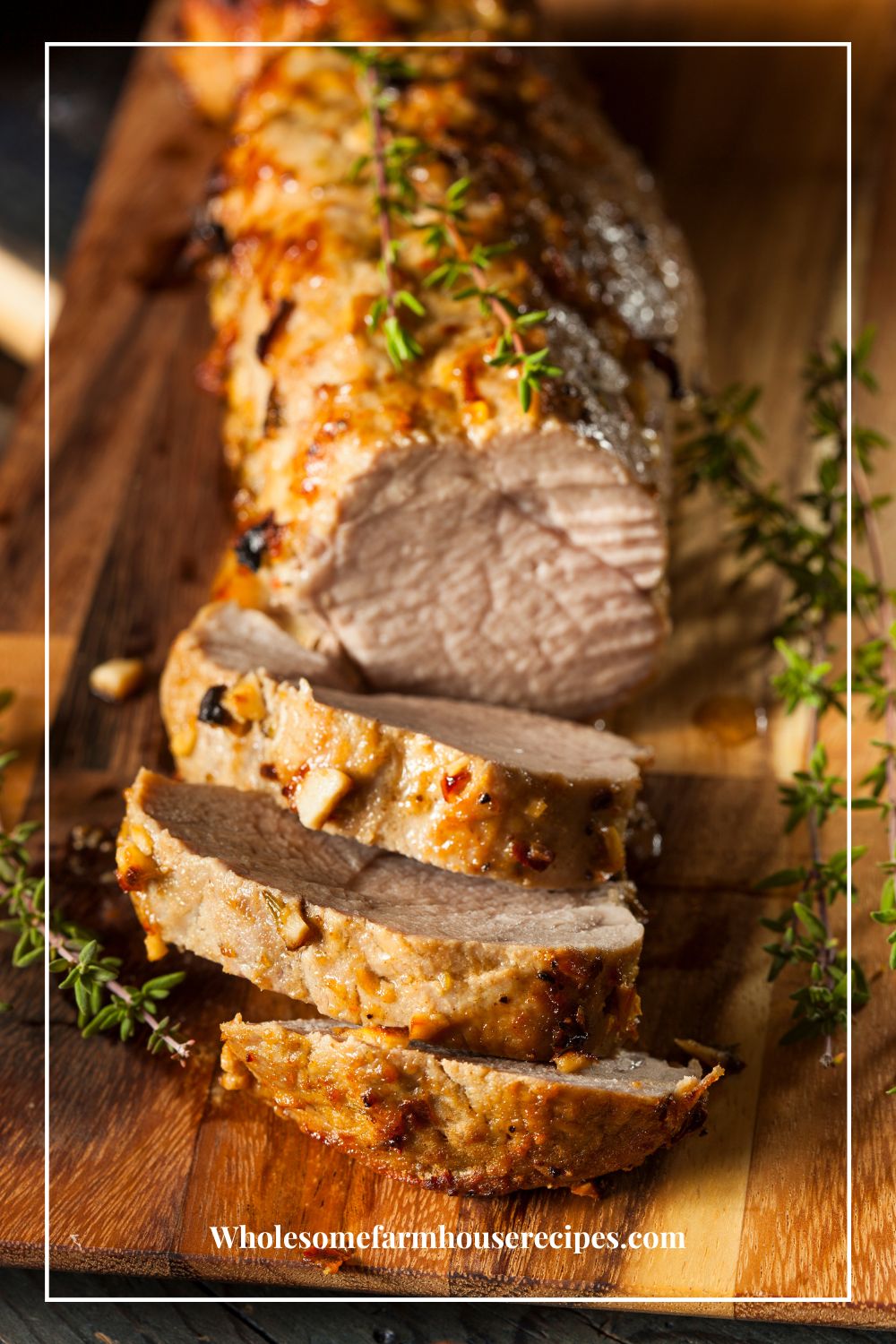
Things That Will Affect the Cooking Time of Pork
Weight and Size
The best way to make the perfect tenderloin is to check the weight. The weight and size of your pork tenderloin play a big role in how long it takes to cook. It’s a simple equation: the larger the tenderloin, the longer it needs to be in the oven, on the grill, or in the pan.
If you’ve got a hefty one-pound tenderloin, it won’t cook as quickly as a smaller one. So, be sure to check the weight and size of your cut before you start cooking to get the timing right.
Cooking Temperature and Method
The cooking method and temperature you choose also impact the cooking time. If you’re roasting your pork tenderloin in a blazing hot oven, it’ll cook faster than if you’re using a lower temperature. For example, a high-heat roast might take around 15-20 minutes per pound, while a slower, lower-temperature roast could take closer to 25-30 minutes per pound. The same goes for grilling or pan-searing; hotter and faster or slower and lower, it all makes a difference.
Initial Temperature Before Cooking
The starting temperature of your pork tenderloin is another piece of the puzzle. If your meat is ice-cold from the fridge, it’ll take longer to cook through compared to a tenderloin that’s been brought closer to room temperature. So, if you’re in a rush, take your pork out of the fridge a little ahead of time to give it a head start.
Let’s explore how to make the best pork tenderloin no matter what method or seasoning you are using.
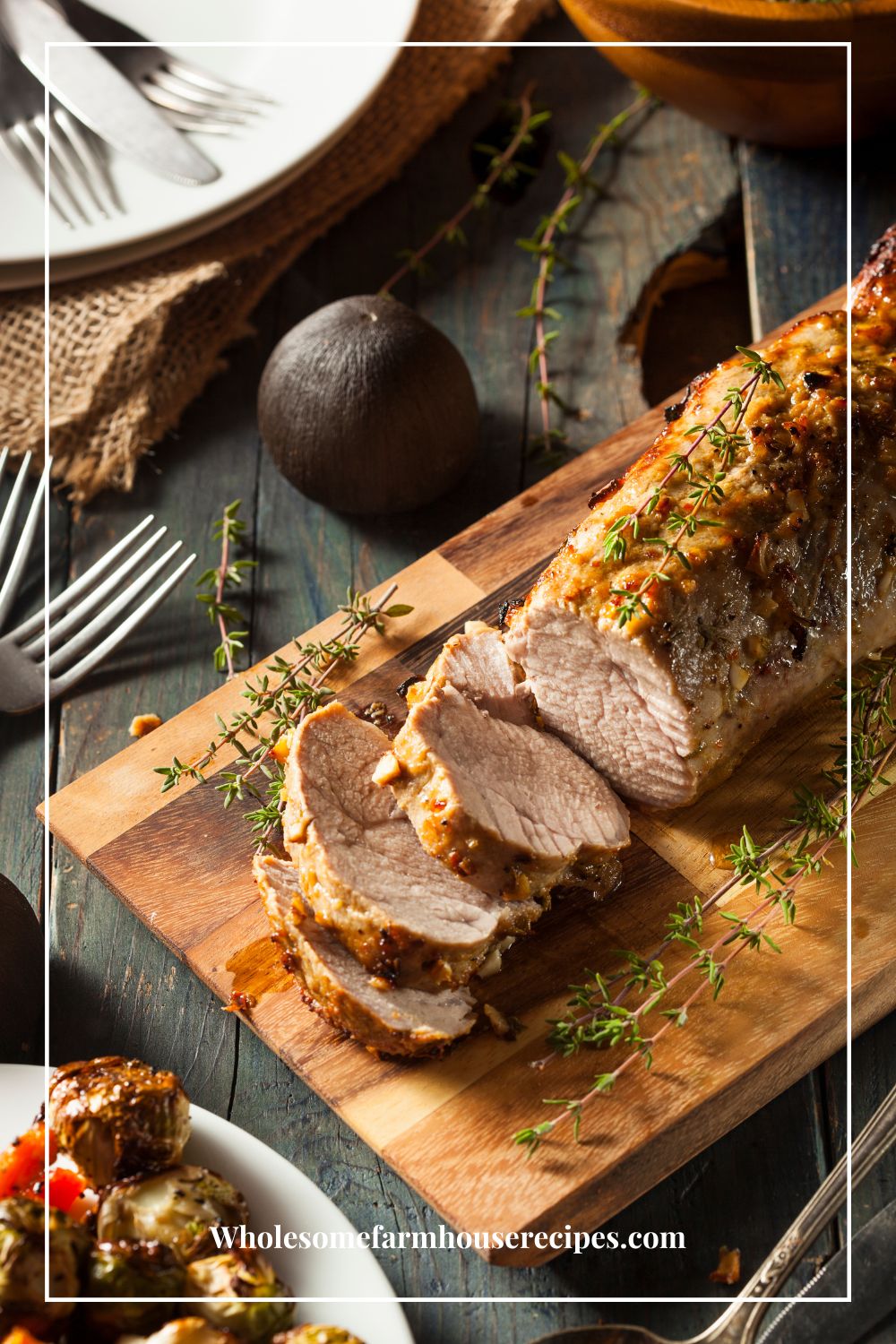
How Long to Cook Pork Perfect Tenderloin Per Pound
To achieve a perfectly cooked pork tenderloin, you can follow the rule of thumb: cook it for approximately 15-20 minutes per pound at an oven temperature of around 375°F (190°C).
However, according to USDA guidelines, it’s essential to use an internal meat thermometer to check for doneness, as the specific cooking time may vary depending on factors like the initial temperature of the meat and your chosen cooking method.
The target internal temperature for cooked pork tenderloin is 145°F (63°C) when inserted into the thickest part of the meat. When the tenderloin reaches this temperature, it is safe to eat, tender, and juicy. Allowing the meat to rest for a few minutes after cooking helps the juices redistribute and keeps the pork even more flavorful and succulent.
While the 15-20 minutes per pound guideline is a helpful starting point, always use a meat thermometer to ensure that your pork tenderloin is perfectly cooked, as actual cooking times may vary based on factors such as the size and initial temperature of the tenderloin, as well as the specific cooking method and equipment you’re using.
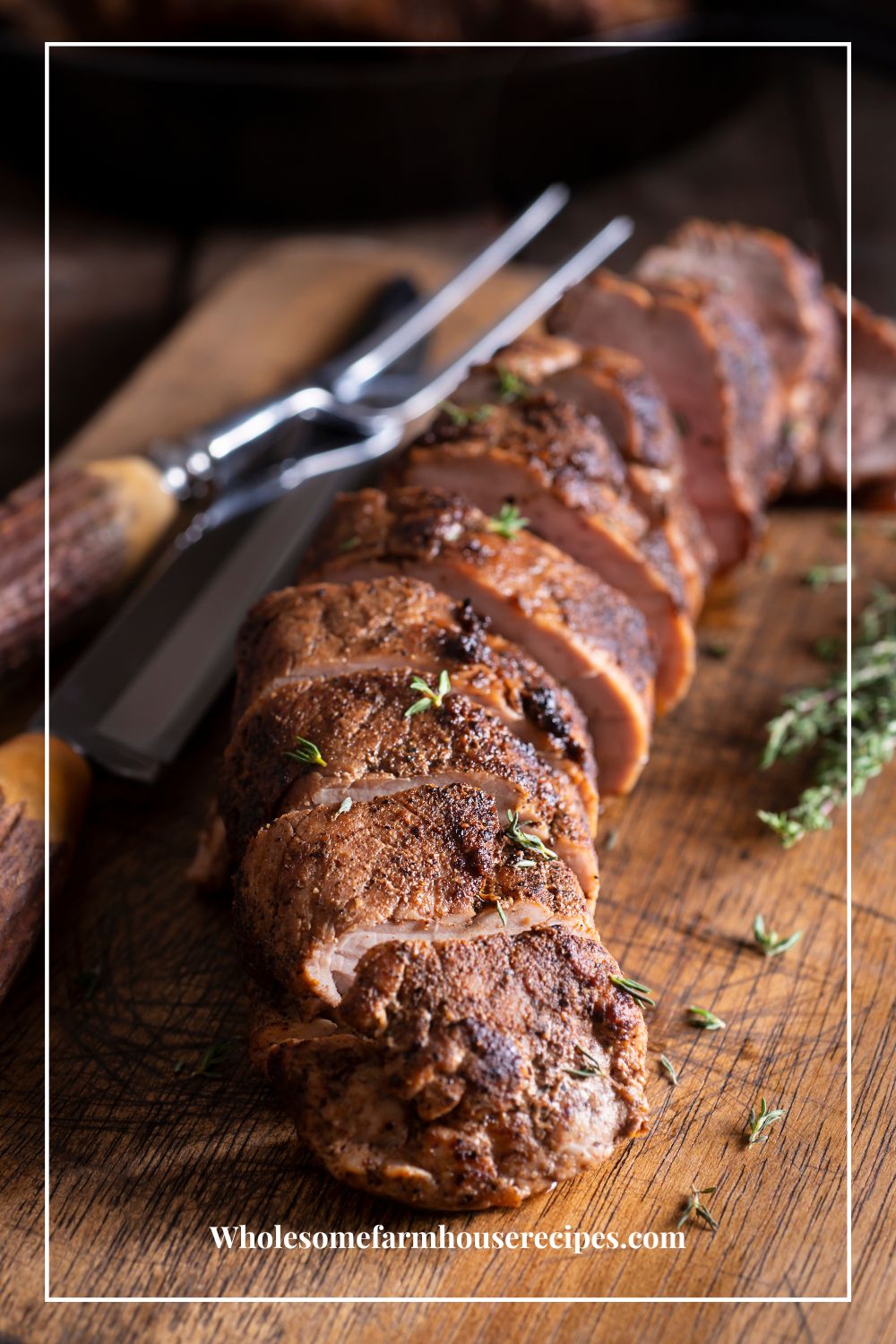
Pork Tenderloin Cooking Guidelines
Check the Weight
No matter what method you will be using to cook your pork, you can be assured perfect results if you know how much it weighs.
Let’s explore different ways to cook.
Oven-Roasting Method
Start by preheating your oven. This gets it nice and toasty, ready to work its magic. For pork tenderloin, the sweet spot temperature is around 375°F (190°C).
Season with your favorite flavors; a sprinkle of salt, a dash of black pepper, brown sugar, onion powder, garlic powder, or maybe some herbs or spices. You can even use a marinade for extra flavor.
Then, place it on a baking sheet, Dutch oven, or in a roasting pan.
As for how long to roast it, it depends on the weight. A rough estimate is about 20-25 minutes per pound. For best results, use an instant-read thermometer to check when it reaches an internal temperature of 145°F (63°C). That’s the magic number for perfectly cooked pork.
Once it’s out of the oven, resist the urge to dive in right away. Let your pork tenderloin rest for a few minutes. This resting time helps the juices redistribute, and it’ll be even more tender and flavorful when you slice it up.
Grilling Method
Fire up your grill and give it some time to heat up. You want a medium-high heat, around 400°F (200°C). Clean and oil the grates to prevent sticking. If you are new to grilling, we can help you with tips on How to Keep a Charcoal Grill Lit.
Set your charcoal grill up with the coals on one side. If you have a gas grill, turn the burners on one side on high and the other side on low.
Season and prepare the meat just like with the oven method. Just season your tenderloin with your chosen spices or marinade. Then, place it on the grill.
Next, sear the tenderloin over the high heat for 2 minutes per side to get beautiful grill marks. The side over the coals. You will get those gorgeous grill marks and seal in the juices.
Then move to the cooler side of the grill and finish cooking over indirect heat keeping the grill covered the whole time to keep the heat in. Cooking time will vary depending on the weight.
Grill your pork for about 15-20 minutes per pound, turning it occasionally. Use that trusty meat thermometer again to check for an internal temperature of 145°F (63°C).
Rest the pork before slicing and serving.
Stovetop and Pan-Searing Method
Heat a skillet or pan over medium-high heat. I like to use a sturdy skillet like a cast iron. Add a little oil to prevent sticking.
Season your tenderloin as usual, then place it in the hot pan.
Cooking Time and Temperature. For pan-searing, it’s a bit quicker; about 5-7 minutes per side, depending on the thickness. Use the meat thermometer to check that internal temperature of 145°F (63°C).
And that’s it!
Whether you’re roasting, grilling, or pan-searing, these simple steps ensure your pork tenderloin is cooked to perfection. Remember, the weight of your pork is your timer, and a meat thermometer is your best friend to avoid guesswork. Enjoy your delicious, juicy pork dinner!
How to Cook Pork Tenderloin in the Oven Without Searing
As an Amazon Associate I earn from qualifying purchases.
Kitchen Essentials
Ingredients
- 1 Pound pork tenderloin
- Olive oil
- 1 Teaspoon Salt
- 1 Teaspoon Black Pepper
- 1 Teaspoon Onion Powder
- 1 Teaspoon Garlic Powder
- 2 Tablespoons Brown Sugar
Instructions
- Start by preheating your oven to 375°F (190°C). While the oven is heating up, you can prepare your pork tenderloin.
- Remove the pork tenderloin from its packaging and pat it dry with paper towels. This helps the seasonings adhere better and promotes even browning in the oven.1 Pound pork tenderloin
- Rub the pork tenderloin with a bit of olive oil to help it brown and add moisture.Olive oil
- In a small bowl, combine the salt, black pepper, onion powder, garlic powder, and brown sugar. Season the pork generously with your spice rub.1 Teaspoon Salt, 1 Teaspoon Black Pepper, 1 Teaspoon Onion Powder, 1 Teaspoon Garlic Powder, 2 Tablespoons Brown Sugar
- Transfer the seasoned pork tenderloin to a baking dish. You can use a roasting pan, a glass baking dish, or any oven-safe cookware that comfortably accommodates the tenderloin.
- Put the baking dish with the pork in the preheated oven. The cooking time will depend on the size and weight of your pork tenderloin. As a general guideline, cook it for about 20-30 minutes per pound. A meat thermometer is your best friend here. The pork is ready when its internal temperature reaches 145°F (63°C).
- Around the estimated cooking time, start checking the internal temperature of the pork with a meat thermometer. Insert the thermometer into the thickest part of the tenderloin without touching the bone.
- Once the pork reaches 145°F (63°C), it’s safe to eat. If it’s not there yet, continue to roast and check the temperature every few minutes to avoid overcooking.
- Remove the pork tenderloin from the oven and place it on a cutting board. Tent it loosely with aluminum foil and allow it to rest for 5-10 minutes. Resting helps the juices redistribute, keeping the pork tender and flavorful.
- After resting, slice the pork tenderloin into medallions and serve it with your choice of side dishes and sauces.
Your Own Private Notes
Notes
Can pork tenderloin be pink inside?
Yes, the recommended doneness according to USDA Guidelines for pork is 145F, which will have pink inside. We pull the pork from the oven at 140F, and the meat continues to cook another 5 degrees, so it’s perfectly done.How do you store leftover roasted pork tenderloin?
Keep in an airtight container in the fridge for up to 5 days. You can freeze for up to 3 months. To thaw, place in the fridge overnight. You can reheat from frozen, but you run the risk of overcooking the meat.How do you reheat leftover roasted pork tenderloin?
The two best methods are in the microwave or the oven. Reheat in the microwave, cover the meat and microwave in 30 second intervals on 70% power, until warmed through. Timing will depend on how much you’re heating, but one serving (6 ounces) should take about 1 minute. Reheat in the Oven for 10-15 minutes at 300 F. Wrap in foil to prevent drying out.Nutrition
Side Dishes and Accompaniments
Whether you are making this at home for a busy weeknight meal, weekend family sit down meal or a dinner party, we have some easy pairing ideas for you.
Mashed Potatoes. Creamy mashed potatoes are a classic side dish that pairs beautifully with pork tenderloin. The rich, buttery texture complements the lean cut of meat and creates a satisfying combination.
Roasted Vegetables. Roasting vegetables such as carrots, asparagus, or Brussels sprouts brings out their natural sweetness and provides a lovely contrast to the savory pork. The caramelization adds depth of flavor.
Applesauce. A dollop of homemade or store-bought applesauce is a traditional accompaniment to pork. Its natural sweetness and slight tartness balance the savory flavors of the meat.
Rice or Grains. Serving your pork tenderloin with rice or a grain like quinoa or couscous can add variety and create a well-rounded meal. Consider mixing in herbs or nuts for added flavor and texture.
Salads. A fresh garden salad or coleslaw can provide a refreshing contrast to the richness of the pork. Opt for light vinaigrette dressings or citrus-based salads to cut through the meat’s richness.
Sauces. Experiment with different sauces like mushroom gravy, Dijon mustard, bbq sauce, or a fruity chutney to drizzle over your pork for extra flavor. A well-paired sauce can elevate your dish to the next level.
Bread or Rolls. Warm, crusty bread or rolls are perfect for sopping up any delicious juices or sauces that accompany your pork tenderloin.
Wine and Beverage Pairings
Red Wine. A medium to full-bodied red wine like Pinot Noir, Merlot, or Syrah pairs well with pork tenderloin. The fruity and slightly acidic notes in these wines complement the pork’s flavors.
White Wine. A crisp, lightly oaked Chardonnay or a dry Riesling can be excellent choices for white wine enthusiasts. The acidity and fruitiness in these wines contrast with the meat’s richness.
Rosé. A dry or off-dry rosé is a versatile option that can work with both white and red meat dishes. Its refreshing qualities make it a great choice for a warm-weather meal.
Beer. For beer lovers, consider a mild ale, a lager, or a light craft beer to accompany your pork tenderloin. These choices provide a nice balance to the meat’s flavors.
Cocktails. If you prefer cocktails, a classic Old Fashioned or a whiskey-based drink can be a delightful pairing, especially if your pork tenderloin has a smoky or slightly sweet seasoning.
Non-Alcoholic Options. Don’t forget about non-alcoholic options like sparkling water, iced tea, or a mocktail with citrus and herbs. These can be great choices to refresh your palate.
Ultimately, the best side dishes and beverage pairings for your pork tenderloin depend on your personal preferences and the specific flavors of your meal. Feel free to mix and match to create a meal that suits your taste and makes your dining experience even more enjoyable.
What are Common Mistakes People Make When Cooking Pork?
Cooking pork can be a delicious endeavor, but there are common mistakes that people often make. Avoiding these errors will help you achieve perfectly cooked and safe pork dishes.
Overcooking
Overcooked pork becomes dry and tough. Use a meat thermometer to ensure you cook the pork to the recommended internal temperature (145°F or 63°C for pork tenderloin). Remember that the meat continues to cook while resting, so take it out just before it reaches the desired temperature.
Under Seasoning
Pork benefits from seasoning to enhance its flavor. Don’t forget to season with salt, pepper, and another spice rub with spices or herbs. A well-seasoned pork dish is more flavorful and satisfying.
Skipping Resting Time
Allowing your cooked pork to rest for a few minutes before slicing is crucial. Resting helps the juices redistribute, resulting in a juicier and more tender final product.
Not Using a Meat Thermometer
Relying solely on cooking times can lead to overcooking. Invest in a good meat thermometer to accurately monitor the internal temperature of the pork and ensure it’s safe to eat.
Inadequate Preparation
Not patting the pork dry before cooking or forgetting to rub it with oil can affect browning and overall texture. Properly dry with a paper towel and season the meat before cooking.
Using High Heat Continuously
While a high temperature is great for searing, using it for the entire cooking process can lead to burning or uneven cooking. Use moderate heat when roasting, grilling, or pan-searing.
Not Monitoring the Meat
Leaving the pork unattended while cooking can lead to overcooking or burning. Stay vigilant, especially when using high-heat cooking methods.
Using the Wrong Cut for the Cooking Method
Not all pork cuts are suitable for every cooking method. For example, pork tenderloin is great for roasting or grilling, while tougher cuts like pork shoulder are better for slow cooking.
By avoiding these common mistakes, you can ensure that your pork dishes turn out beautifully, whether you’re roasting, grilling, pan-searing, or slow-cooking this versatile and delicious meat.
Can pork tenderloin be pink inside?
Yes, the recommended doneness according to USDA Guidelines for pork is 145F, which will have pink inside. We pull the pork from the oven at 140F, and the meat continues to cook another 5 degrees, so it’s perfectly done.
How do you store leftover roasted pork tenderloin?
Keep in an airtight container in the fridge for up to 5 days. You can freeze for up to 3 months.
To thaw, place in the fridge overnight. You can reheat from frozen, but you run the risk of overcooking the meat.
How do you reheat leftover roasted pork tenderloin?
The two best methods are in the microwave or the oven.
Reheat in the microwave, cover the meat and microwave in 30 second intervals on 70% power, until warmed through. Timing will depend on how much you’re heating, but one serving (6 ounces) should take about 1 minute.
Reheat in the Oven for 10-15 minutes at 300 F. Wrap in foil to prevent drying out.
Will this pork loin shred?
No, this is not the right cut to use for shredding. This is great for slicing. Use a shoulder cut if you want to make Pulled Pork recipe.
You can find out more about how much pulled pork to plan per person.


